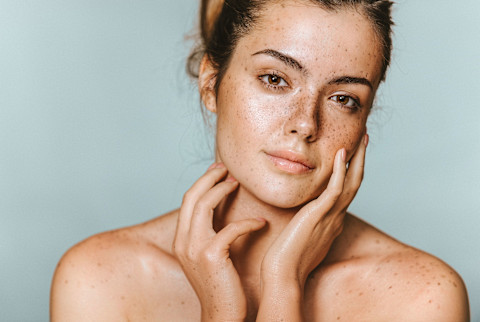PSA: You Can Change The Oil Composition In Your Skin — Here's How

This might come as a surprise, but you can't actually change your skin type with products. Sure, your skin's texture and tone may fluctuate throughout the seasons (i.e., you can expect some dryness during a cold, brittle winter), as does your skin evolve as you age or with hormone fluctuations. But your true, foundational skin type? It's fairly locked in.
Especially for those with oily skin: The skin type largely depends on genetics—sometimes people simply have larger sebaceous glands (a fancy word for pores) that can easily produce oil on overdrive.
OK, so oily skin just might be in your family tree (sigh), but you can change the quality of the oil itself. What do we mean? Allow us.
Your skin type can't change. But the oil itself can
First things first: Oily skin isn't a bad thing. Those healthy lipids on the surface of your skin contain ceramides, fatty acids, and other crucial elements to retain moisture and protect your skin barrier. When it's balanced, you might find the oil is totally manageable—reminiscent of a healthy glow—even though your skin is still technically "oilier" than others'.
It's the overproduction of oil that frequently becomes an issue, where the buildup of sebum actually transforms in quality. "With the overproduction of sebum, that sebum is a little bit different in composition," celebrity esthetician Alicia Yoon, founder of Peach & Lily, tells mbg. "There are more wax esters, it's a little bit glassier, and the oil can look more yellow versus clear." That thick, yellowish oil is the substance you might associate with "oily skin," but the actual amount isn't necessarily the problem (and no magical number of blotting papers will make it more manageable): All you need to do is transform the oil composition back to its clear, dewy quality.
How to change your oil composition
So how do you change your oil composition back to the glowy, healthy lipids you love? When you hydrate your skin, it actually produces different kinds of oils, says Yoon—the lipids that make your skin look supple and dewy, never greasy. What's more, supplying your skin with some much-needed hydration can even reduce some of that excess sebum (read: dehydrated skin can respond with even more oil production, in a twisted turn of events).
But the real kicker here is the change in composition—instead of thick, yellowish, and greasy, it's clear and makes your skin look plump. "It's not just less," Yoon explains. "The oil composition feels different. Some of my clients will say, 'I still have oily skin. It just feels better.'"
So rather than slathering on purifying and clarifying ingredients to reduce the oil and calling it a day, show the oil some love: Properly hydrate, exfoliate, and hydrate again to ensure your sebum is of the highest quality.
The takeaway
If you have oily skin, most of your focus might be on ways to reduce the shine. But perhaps it's time to focus on quality, not quantity: As Yoon will tell you, changing the composition of the oil itself has a much better payoff. You'll still technically have "oily" skin, but it's the clear, dewy oil that many beauty fans actually strive for (and you already have!).
